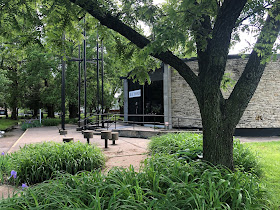 |
| Somehow I managed a smile after birds destroyed my soul at Lone Jack (Mo.) battlefield. (CLICK ON IMAGES TO ENLARGE.) |
 |
| The small museum on the battlefield was dedicated by former president Harry S. Truman in 1963. |
 |
| A severe storm in the Kansas City area toppled trees at Lone Jack the night before my visit. |
 |
| Confederates attacked Union lines (behind camera) through a field across the road on Aug. 16, 1862. |
Here's what you need to know about the Trans-Mississippi Theater site: The battle, fought August 15-16, 1862, resulted in a Confederate victory. Estimated casualties: about 300. Confederates charged through a hemp field to attack Union soldiers in a cornfield, now long gone. The dead were buried on the battlefield and, according to the docent, some may lie in a trench that extends beyond the boundary of the small cemetery.
 Former President Harry S. Truman, who lived in nearby Independence, Mo., dedicated the museum, housed in a circular stone and cement building, in 1963. "I tried to more than 42 years ago to erect a monument to the Lone Jack battle," Truman said on the 101st anniversary of the fighting. "They didn't think the battle was important then."
Former President Harry S. Truman, who lived in nearby Independence, Mo., dedicated the museum, housed in a circular stone and cement building, in 1963. "I tried to more than 42 years ago to erect a monument to the Lone Jack battle," Truman said on the 101st anniversary of the fighting. "They didn't think the battle was important then."The battle lives on in popular culture -- well, at least for those who recall an actor named John Wayne. Asked in the movie True Grit how he lost his eye, Wayne -- who played Rooster Cogburn -- replied: "It was in the war. The Lone Jack, a scrap outside Kansas City." (You can't find this stuff almost anywhere else. Here's a clip from the 1969 movie.)
For at least one Union soldier, the battle was unforgettable. Wrote Stephen Benton Elkins, a captain of militia in the 77th Missouri and later Secretary of War and a U.S. Senator from West Virginia:
"I saw one battle while in the service, that of Lone Jack, and a most awful battle it was. Col. Emory S. Foster had a Union regiment which was attacked by the brother of Senator Cockrell, but Foster thought the Confederates were the guerrilla hands who raised the black flag, and never gave any quarter. So he refused to surrender, and every one of his officers was picked off.
Elkins
"The guerrillas were victorious. I went over the battlefield afterward, the blood, the cries for water and death, the naked bodies stripped of their clothing, the dead horses which served for ramparts, gave me a disgust for war, which makes it seem strange that I am here at the head of the war department of this great government."
(Click at upper right for full-screen experience.)
 |
| A Confederate memorial in the small battlefield cemetery. |
 |
| A Union memorial (left) steps from the Confederate memorial at Lone Jack Cemetery. |
 |
| Gravestone for Union corporal who was killed at the Battle of Lone Jack. |
-- Have something to add (or correct) in this post? E-mail me here.
SOURCES:
-- Stevens, Walter Barlow, Centennial History of Missouri, S.J. Clarke Publishing. 1921.
-- The Kansas City Times, Aug. 17, 1963.

I was there nine years ago and it seemed pretty neat. No museum, though. Do you know when it opened ?
ReplyDeleteThe Museum has been there since 1963. Commemorated on August 16, 1963: 101 years from the date of the battle.
DeleteSorry about the birds, John. We Missourians generally are a little more welcoming than that. Good story with insight I didn't know about, despite reading in the past about the fight. Digging such up is one of your great knacks as a writer. BTW, did you come all the way to Missouri just to go to Lone Jack?
ReplyDeleteI am just rambling about, mostly aimlessly, according to Mrs. Banks. :)
ReplyDeleteWhere are the birds?
ReplyDeleteI just read the article about the what happened at Ford's theater in 1893 when it was the records and pension office I thought I know about everything to do with history before and after the war your story well done
ReplyDeleteThanks for the kind words.... :)
DeleteI live in lone jack. I’m running athlete now training to join the US marines, so I jog past that old battlefield multiple times a week. And I must say that living right next to a mass grave of Union and Confederate soldiers is just about as eerie and spooky as it sounds. People speak of seeing soldiers walking around at night and in the fields surrounding the town. Despite all the years of development this area of the country has gone through lone Jack is still quite small and rural. Hasn’t changed much. I love living here but sometimes I feel like there’s just something quite off about this town. Something very unsettling.
ReplyDelete